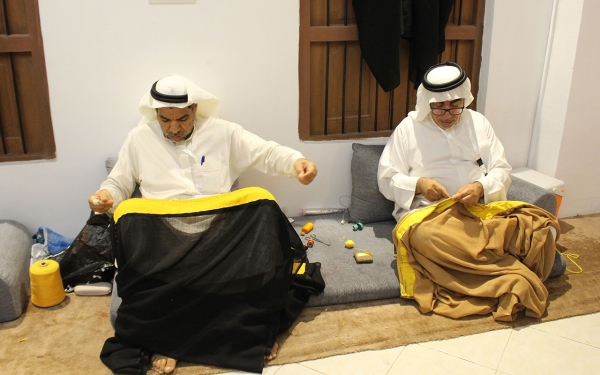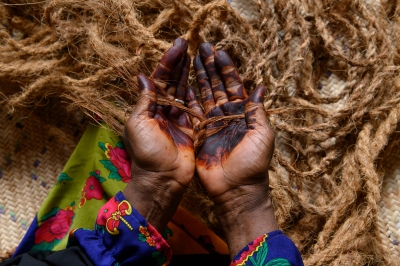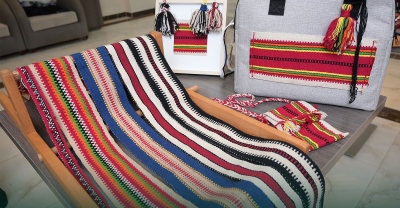

Textile Weaving in al-Ahsa is one of the traditional folk crafts in al-Ahsa Governorate, Eastern Province, Kingdom of Saudi Arabia. Well-known families from al-Ahsa are famous for textile weaving, with each generation passing down the secrets and traditions from father to son, through education and collaborative efforts.
History of textile weaving in al-Ahsa
Al-Ahsa was famous for weaving various types of textiles, with several cities and villages standing out in this craft. Foremost among them was the city of Hajer, known for weaving Hajeri garments and Hajeri Ma'qad. Its textiles were sought after by people in markets. Sources mentioned that Prophet Muhammad, peace be upon him (PBUH), bought fabrics woven in Hajer and brought by merchants from the people of Bahrain. It was also mentioned that Abu Musa al-Ash'ari (may Allah be pleased with him) clothed two garments from Ma'qad of Bahrain as an expiation for breaking an oath.
The historic city of al-Ahsa had a significant presence in this industry. The Persian traveler Nasir Khusraw mentioned when he visited it in 1051 that al-Ahsa produced a type of luxurious towel described as short, thickly woven, and striped. These towels were carried to Basra for trade and from there to the far corners of the world.
Additionally, the presence of al-Ahsa in the textile industry continued until the era of the First Saudi State, as it was chosen as a source for producing textiles that caught the attention of members of the royal family. This encouragement reached its peak when al-Ahsa was nominated to weave the Kiswa of al-Kaaba al-Musharrafa, and this Kiswa was woven during the reign of Imam Saud Bin Abdulaziz after he extended his influence over the Hijaz in 1811. He covered al-Kaaba with a Qailani Hasawi Kiswa, woven in Farij al-Muqabil. Farij refers to a district or neighborhood in the city of al-Mubarraz.
Families involved in textile weaving
Those families were primarily concentrated in al-Hufuf, al-Mubarraz, and a few villages, notably the villages of al-Tarf and al-Halilah. Textile weaving shops in al-Hufuf, particularly, are concentrated in the Farij of al-Rifaa al-Shamali and al-Naathil, while in al-Mubarraz, the most important weaving shops are concentrated in the Farij of al-Muqabil and al-Uyouni, in addition to the Farij of al-Shu'bah and al-Sayasib.
Yarn for textile weaving
Like other industries, textile weaving in al-Ahsa uses yarn as raw material. Weavers utilize various types of locally prepared and spun yarn. Al-Ahsa has its specialized markets, called Souq al-Ghazl (Yarn Markets). One of the most prominent ones was the Yarn Market in al-Hufuf, located in al-Shutayyib area opposite the Municipality of al-Hufuf. Additionally, there was Souq al-Dihn (Oil Market), which is now replaced by Souq al-Dahab (Gold Market). In al-Mubarraz, one of the prominent yarn markets was the Wednesday Market, located next to the Jil'ah. There was also the Yarn and Oil Market located in the dyehouse west of Farij al-Shu'bah.
The provision of textile yarn saw activity, with certain families specializing in importing them from Bahrain, India, Iran, Iraq, and the Levant. Among the prominent suppliers of yarn in al-Hufuf were the families of al-Bou Ali, Abdullah al-Marzouq, al-Hilal, Saleh and Taher al-Amer, and Suleiman al-Ghunaim. The most important types of yarn used in textile weaving in al-Ahsa were camel hair and sheep wool. These two types were considered the main materials for yarn and were locally sourced.
The importation of yarn for textile weaving in al-Ahsa also included importing various types of staple yarn from Iraq, Khuzestan, and Bushehr in Iran, as well as cotton. Some farmers in al-Ahsa cultivated cotton on a limited scale, and its yarn was used in weaving Taqiyah (caps) and lightweight textiles. Silk was also imported from Syria and India as spun and dyed yarn known as Ibraysam (Silk that is disentangled before the worm leaves the cocoon). Some luxurious women's textiles were woven from this material.
Mishlah manufacturing (Bisht)
Al-Ahsa Governorate is distinguished for manufacturing the Mishlah or Bisht, and it has started to export them to various countries around the world. 'Al-Hasawi Bisht' is considered one of the finest types of Mishlah, prominently present in both local and international forums, due to its unique and renowned quality of craftsmanship, precision, mastery, high skill, and aesthetic touches, and is now exported to various countries. Among its most prominent types in terms of weaving are: al-Malaki (royal), al-Mukhawmis, al-Mutawasi', al-Tabouk, al-Maruba, and al-Maqta.
Al-Ahsa Governorate was the first to start the manufacturing and weaving of Mishlah, becoming one of the most important markets for producing and exporting Mishlah in the Kingdom and the Gulf Cooperation Council countries. The process of weaving al-Ahsa Cloak extends from ten days to six months and goes through seven stages, starting with al-Tarkeeb, al-Tawq, al-Haila, al-Buruj, al-Maqsar, al-Qitan and al-Khabana, and finally, the stage of al-Bardakh in which the zari is embroidered, bringing out its golden color.
Related quizzes
Related articles

